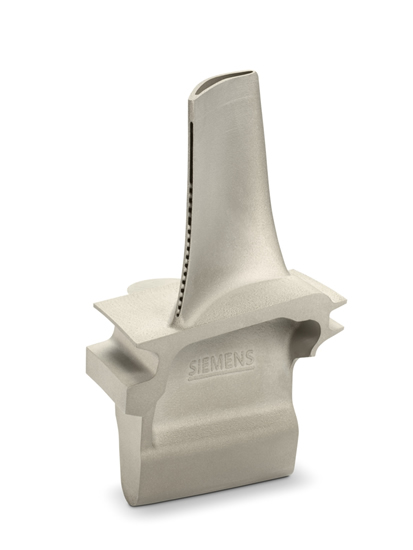Breakthrough with 3D printed Gas Turbine Blades
Siemens has achieved a breakthrough in the 3D printing of gas turbine blades. For the first time, a team of experts has full-load tested gas turbine blades that were entirely produced using additive manufacturing.
The tests were conducted at the Siemens test center for industrial gas turbines in Lincoln, Great Britain. Over the course of several months, Siemens engineers from Lincoln, Berlin, and the Swedish municipality of Finspong worked with experts from Materials Solutions to optimize the gas turbine blades and their production. Within just 18 months, the international project team succeeded in developing the entire process chain, from the design of individual components, to the development of materials, all the way to new methods of quality control and the simulation of component service life. In addition, Siemens tested a new additively manufactured blade design with a fully revised and improved internal cooling geometry.
1000 mph, carrying 11 tons
“This is a groundbreaking success for the use of additive manufacturing in the field of power generation, one of the most demanding areas of application for this technology,” says Willi Meixner, CEO of Siemens Power and Gas Division. “Additive manufacturing is a major pillar in our digitization strategy. The successful tests resulted from the efforts of a committed international project team comprising Siemens engineers from Finspong, Lincoln, and Berlin, as well as experts from Materials Solutions,” adds Meixner.
The turbine blades were installed in a 13-megawatt (MW) SGT-400-type industrial gas turbine. The printed turbine blades were produced from a high-temperature-resistant, powdered polycrystalline nickel-based superalloy and are able to withstand the high pressures, extreme temperatures, and centrifugal forces that arise during turbine operation.
Gas turbine blades must withstand extreme conditions. Inside a turbine, high pressures, tremendous centrifugal forces, and high temperatures prevail: At full power, blades rotate at 1,600 km/h – twice the speed that a Boeing 737 can fly – and carry loads of 11 tons, which is approximately the weight of a fully loaded London double-decker bus. The blades must also withstand tremendous heat because they’re surrounded by 1,250°C gas when the turbine is in full operation.
3D Printing Revolutionizes Gas Turbine Blade Production
Until now, blades for gas turbines were either cast or forged. The casting of turbine blades requires complex mold construction before each blade can be individually cast – a complex, time-consuming, and costly procedure. Additive manufacturing changes all this. With AM, a laser beam is directed at fine layers of metal powder, which are heated and melted. When the laser is removed, the metal cools. The process is repeated layer by layer until the blade model from the 3D printer is finished. Thanks to additive manufacturing, the team was able to reduce the period of time from the design of a new gas turbine blade to its production from two years to two months.
“Exciting AM technology changes the way we produce. Using this technology, we can develop prototypes up to 90 percent faster,” says Meixner. “Siemens is a pioneer in the field of additive manufacturing. We’re speeding up the development of new gas turbines with higher efficiency levels and increased availability and can thus deliver these improvements to our customers faster. The new flexibility in production allows us to more precisely tailor development to our customers’ requirements and deliver individual spare parts on demand.”
Contact:
Sebastian Webel
Editorial Office
Siemens AG
sebastian.webel@siemens.com
Original Internet Article:
https://www.siemens.com/innovation/en/home/pictures-of-the-future/industry-and-automation/additive-manufacturing-3d-printed-gas-turbine-blades.html
Pictures of the Future
https://www.siemens.com/innovation/en/home/pictures-of-the-future.html
Ähnliche Pressemitteilungen im idw



